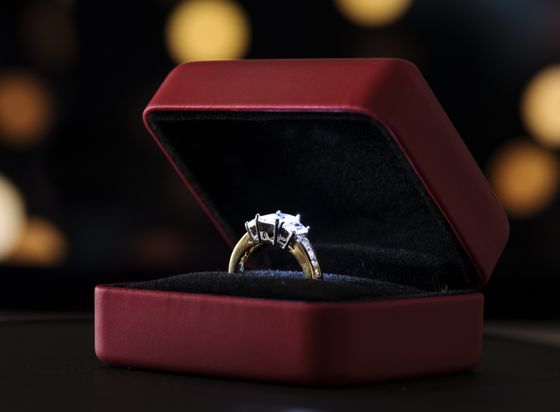How was the illusion of 'rare diamond' created?

by
Edward J. Epstein, an American research journalist and professor of politics at the Massachusetts Institute of Technology, described it as “creating an idea that diamonds are rare and valuable” . Mr. Epstein continues the glittering history of diamonds, from the discovery of the 19th century diamond mine to the rise of the giant cartel.
Have You Ever Tried to Sell a Diamond?-The Atlantic
https://www.theatlantic.com/magazine/archive/1982/02/have-you-ever-tried-to-sell-a-diamond/304575/
Until the middle of the 19th century, diamonds were collected like gold dust from Indian rivers or mined little by little from deposits closed in the Brazilian jungle, so the world's annual diamond production was only a few kilograms. However, as large diamond mines are discovered in South Africa, the gem market will be flooded with diamonds.
Around this time, the diamond mining company De Beers Mining Company, owned by British politician Cecil Rose, who would later be called 'African Napoleon', received another fund from the Rothschilds. In 1888, it became a De Beers joint mining company. This is the beginning of the history of the De Beers group that later ruled diamonds around the world.

by
When the diamonds they produced were to dominate the market, De Beers and De Beers investors realized that their business would not be able to stand in the near future. The essential value of diamonds is their rarity, so if a large number of diamonds are available, the price will drop. As a result, De Beers has adopted a strategy to form a cartel, monopolize the market, and reduce the amount of diamonds in the world.
Although De Beers steadily controlled the jewelry market in this way, it reached its peak in the 1930s. Europe, the main gem market at that time, was in the midst of a global depression . Another factor is that diamonds are recognized as “nobles” and were not viewed by the common people.
Meanwhile, Ernest Oppenheimer 's son, Harry , who was the de facto top of De Beers, met a man named Gerald Luck in New York in 1938. Encountering Luck, president of NWAyer and Son, who is also regarded as the oldest major advertising agency in the United States, later changed the fate of De Beers.
Lack, who has been undertaking the diamond business, is launching the Ayer plan, centered on a long-term image strategy. In the Ayer project, we started by offering diamonds to the British royal couples and trying to combine diamonds with romantic charm. In addition, an advertisement using paintings such as Picasso and Dali was published in a magazine, and the image that diamond was a unique work of art, like the paintings of great masters, was imprinted on the general public.

by
In addition, NWAyer and Son used the movie, which was a new entertainment at the time, to make Hollywood stars wear diamonds to appeal their charm. These brand strategies focused on instilling a “successful role model” into the general public. An internal document created in 1948 by NWAyer and Son says, “Gives the stars of the silver screen and the stage to promote diamonds. 'I want the same thing.' As a result of this successful public relations strategy, diamond sales in the United States increased by over 55% from 1938 to 1941, overturning the previous downturn.
Meanwhile, NWAyer and Son, who was looking for a way to give Diamond an image that combines love and tradition, is an advertisement with a sentence `` A Diamond Is Forever '' under a picture that imaged a couple on their honeymoon Was launched. This is the phrase 'Diamonds are eternal shine' that later became a slogan that symbolizes not only De Beers but also the diamond itself. By creating diamonds that are crushed, chipped, and discolored as a symbol of eternal love, De Beers succeeds in making diamonds a product that is not resold or destroyed.

by Rawpixel
With the American market in hand, De Beers began to look at the jewelry market around the world. Among them, De Beers was particularly successful in Japan after the Second World War. Until 1959, diamonds were not even on the Japanese general market due to legal restrictions. Meanwhile, De Beers, who has partnered with advertising agency J. Walter Thompson , who has subsidiaries all over the world, will make a thorough sales pitch in the Japanese market with the slogan “Salary for 3 months”. The aim of the public relations strategy that 'Women dressed in Western fashion enjoy leisure with smart men' was to modernize Japanese women who were married at the time and were traditionally confused It was to make romance crazy.
The campaign was a huge success, and in 1967 only 5% of those who got married had diamond wedding rings, but in 1972 it surged to 27%. In 1978, half of married women began to receive diamonds. Eventually, the Japanese market will grow into a second market after the United States, with sales of diamond engagement rings.
Since then, De Beers has been selling diamonds all over the world and has been enthusiastic about the diamond industry for a long time, but Epstein predicts that the glory will not last forever. In the 1980s, against the backdrop of Australian diamonds that were out of control of De Beers, Epstein said, “De Beers must be able to find a way to regain control of the market. In time, the value of diamonds will collapse, and it will be remembered as a small stone that was once precious. '
In fact, in recent years, De Beers' struggle has become particularly clear.
Pointing out that the diamond industry does not seem to be eternal even if `` diamond is eternal shine ''-GIGAZINE

Related Posts:
in Note, Posted by log1l_ks






